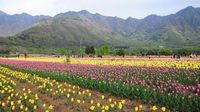Kashmir has recently experienced a significant rise in temperatures, with the Meteorological Department in Srinagar announcing on Tuesday, April 16, 2025, that various districts recorded maximum temperatures considerably above average. Srinagar itself reported a temperature of 30.4°C, marking it as the second-highest maximum temperature recorded in April, just shy of the historical high of 31.1°C set in 1946.
According to Mukhtar Ahmad, the Director of the Meteorological Department (MeT), many weather stations across Kashmir reported increases of 8-11°C above normal. Qazigund, for example, reached 29.8°C, while Kupwara recorded 29.5°C. Other notable temperatures included Kukernag at 27.5°C, Pahalgam at 25.4°C, and even the snow-covered slopes of Gulmarg, which saw temperatures rise to 20.7°C, a startling 11.2°C above normal.
In the Jammu division, the heat was equally intense, with maximum temperatures hitting 35.7°C in Jammu, 25.8°C in Banihal, 24.1°C in Batote, 32.4°C in Katra, and 26.4°C in Bhaderwah. The unexpected heatwave has prompted the MeT to issue weather alerts for the coming days. A yellow alert has been issued for specific regions of Jammu and Kashmir on April 18, followed by both yellow and orange alerts for various areas on April 19.
The yellow alert serves as a cautionary notice to the public, while the orange alert calls for preparedness and active monitoring of weather updates. The department forecasts that while the next two days (April 15 to 17) are expected to remain largely dry, a fresh western disturbance will bring light to moderate rainfall and even snow in higher elevations starting from the evening of April 18.
From April 18 to 20, most areas are likely to experience cloudy skies with light to moderate rain or snow, with the potential for moderate to heavy rainfall at isolated locations, particularly on April 18 and 19. This weather will be accompanied by thunderstorms and gusty winds, raising concerns about possible landslides and mudslides in vulnerable areas.
On April 21, the forecast suggests cloudy conditions with a chance of light rain or thunder in some areas, while a drier spell is expected from April 22 to 25. However, the MeT indicates that another round of clouds and possible precipitation may return between April 26 and 27.
In light of this evolving weather forecast, the Meteorological Department has advised travelers, tourists, and transporters to plan their movements carefully and adhere to traffic and administrative advisories. Farmers have also been urged to complete essential fieldwork by April 17, as the imminent weather changes could pose risks to agricultural activities.
As Kashmir experiences this unusual shift in weather, residents and authorities alike are preparing for the challenges that may arise from the combination of rising temperatures and impending rains. The stark contrast in weather patterns serves as a reminder of the region's climatic variability and the importance of staying informed about weather conditions.






